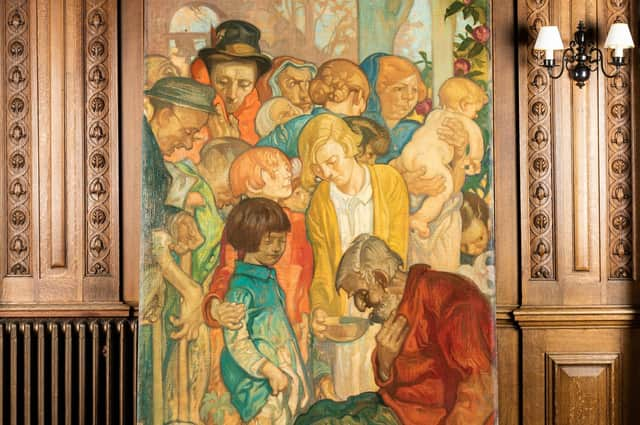Ditchling Museum reimagines Sir Frank Brangwyn


Spokeswoman Abby Butcher said: “The life-size photograph is a reconstruction of Brangwyn’s Education murals, two of eight on public display for the first time at Ditchling Museum of Art + Craft. The large-scale paintings were commissioned by The Skinners’ Company between 1901 and 1912 for Skinners’ Hall in London and depict key moments in the history of the ancient City of London Livery company. The murals take centre stage in a remarkable new exhibition at Ditchling Museum of Art + Craft (until October 16).
“The museum plays host to the panels while Skinners’ Hall undergoes restoration work, offering the public a unique opportunity to see these colossal works of art which are over 2.5 metres in length and will span from floor to ceiling. The panels are usually set above a three-metre-high wainscot in the banqueting hall; in this exhibition they will be presented in a new context, hung at eye level within the intimate setting of the museum.
Advertisement
Hide AdAdvertisement
Hide Ad“Brangwyn, who owned property in Ditchling from 1917 until his death in 1956, often invited local people to pose for his murals and the museum took inspiration from this for the modern reimagining.
“The photograph was staged at The Jointure, Brangwyn’s Ditchling residence and photographed by Katie Vandyck.
" It features children from Ditchling St Margaret's Primary School and Downlands Community School in Hassocks; the school teacher (which is a self-portrait of Brangwyn in the original) is portrayed by Justine Moss, Head of Teaching and Learning (Creative Arts) at Downlands Community School. Also featured are assistant curator for the exhibition Tony Kalume from Diversity Lewes, and local artist and maker Sebastian Pedley.
“The exhibition, Frank Brangwyn: The Skinners’ Hall Murals, will also showcase some of Brangwyn’s photographic studies and sketches for the Skinners’ murals alongside other major commissions including the British Empire murals (1925-32) and New York City's Rockefeller murals (1930-34).
Advertisement
Hide AdAdvertisement
Hide Ad“Brangwyn photographed his models, often using household utensils for props. He then made studies of the photographs using chalk, charcoal and paint.
" These were squared up on enormous canvases by his assistants for the final painting. Visitors to the exhibition can see the various stages of Brangwyn's process.
"They will also have the chance to assume the role of the local models and stage their own mural study with the help of costumes and props.
“The exhibition will provide context for Brangwyn’s time spent in Ditchling’s thriving artist community, displaying his etchings and photographic studies, ceramics and furniture alongside works by his peers including Ethel Mairet, Amy Sawyer, Charles Knight, Louis Ginnett, Hilary Pepler and Edward Johnston.”
ditchlingmuseumartcraft.org.uk.